Gary Boudreau
Channel Estimation with Asynchronous Reception for User-Centric Cell-Free MIMO Systems
Jun 05, 2025Abstract:The user-centric, cell-free wireless network is a promising next-generation communication system, but signal synchronization issues arise due to distributed access points and lack of cellular structure. We propose a novel method to recover synchronous pilot reception by introducing new pilot sequences and a matched filter window, enabling orthogonality even with asynchronous reception. Our approach mimics synchronous transmission by extending training sequences. Analysis shows asynchronous reception's impact on channel estimation, and our method significantly improves performance with a small increase of training time overhead. Results demonstrate a 7.26 dB reduction in normalized mean square error and 40% increase in data rate, achieving performance levels comparable to the synchronous case.
Regularized Top-$k$: A Bayesian Framework for Gradient Sparsification
Jan 10, 2025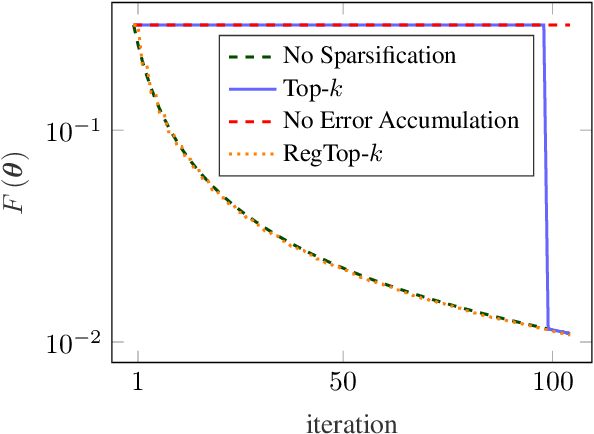
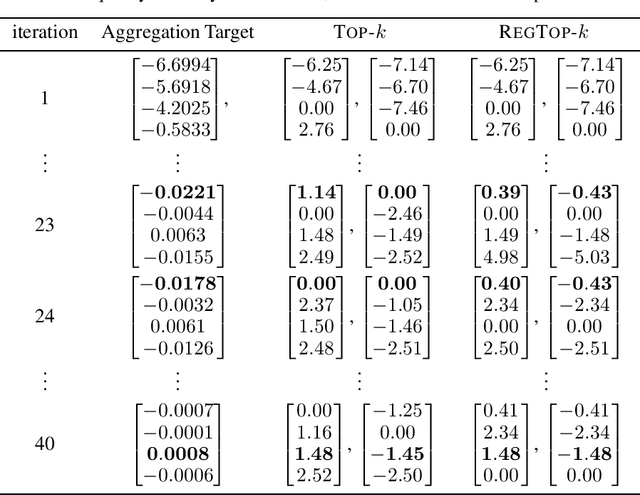
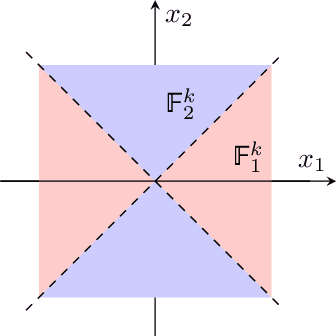
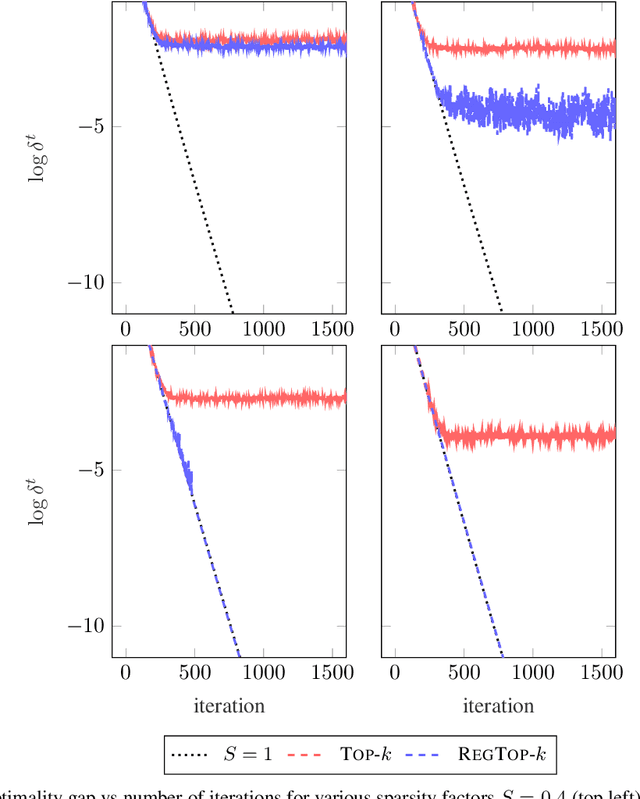
Abstract:Error accumulation is effective for gradient sparsification in distributed settings: initially-unselected gradient entries are eventually selected as their accumulated error exceeds a certain level. The accumulation essentially behaves as a scaling of the learning rate for the selected entries. Although this property prevents the slow-down of lateral movements in distributed gradient descent, it can deteriorate convergence in some settings. This work proposes a novel sparsification scheme that controls the learning rate scaling of error accumulation. The development of this scheme follows two major steps: first, gradient sparsification is formulated as an inverse probability (inference) problem, and the Bayesian optimal sparsification mask is derived as a maximum-a-posteriori estimator. Using the prior distribution inherited from Top-$k$, we derive a new sparsification algorithm which can be interpreted as a regularized form of Top-$k$. We call this algorithm regularized Top-$k$ (RegTop-$k$). It utilizes past aggregated gradients to evaluate posterior statistics of the next aggregation. It then prioritizes the local accumulated gradient entries based on these posterior statistics. We validate our derivation through numerical experiments. In distributed linear regression, it is observed that while Top-$k$ remains at a fixed distance from the global optimum, RegTop-$k$ converges to the global optimum at significantly higher compression ratios. We further demonstrate the generalization of this observation by employing RegTop-$k$ in distributed training of ResNet-18 on CIFAR-10, where it noticeably outperforms Top-$k$.
Handoffs in User-Centric Cell-Free MIMO Networks: A POMDP Framework
Mar 13, 2024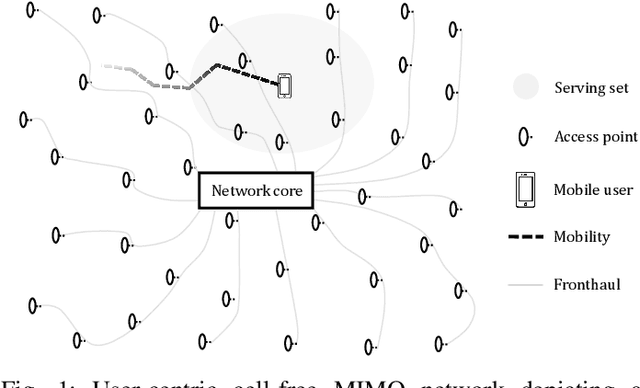
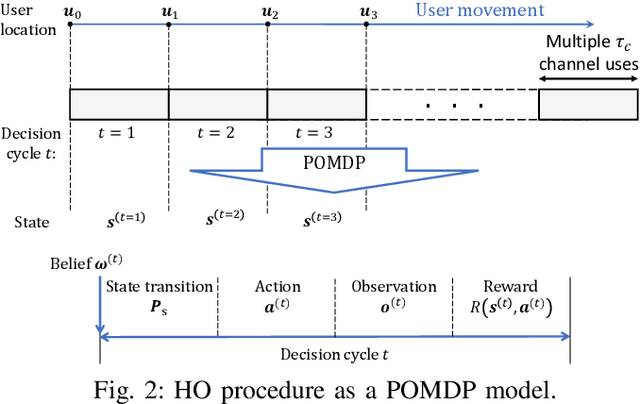
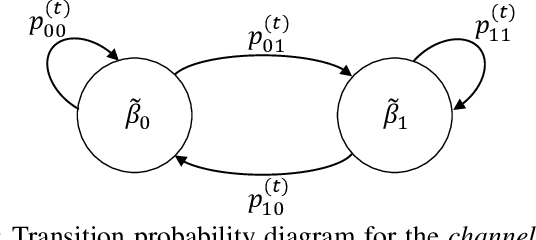
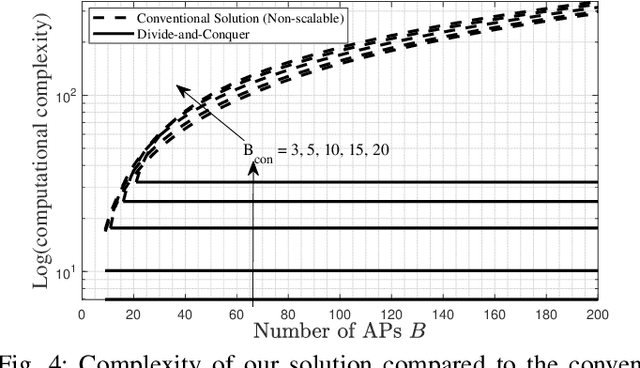
Abstract:We study the problem of managing handoffs (HOs) in user-centric cell-free massive MIMO (UC-mMIMO) networks. Motivated by the importance of controlling the number of HOs and by the correlation between efficient HO decisions and the temporal evolution of the channel conditions, we formulate a partially observable Markov decision process (POMDP) with the state space representing the discrete versions of the large-scale fading and the action space representing the association decisions of the user with the access points (APs). We develop a novel algorithm that employs this model to derive a HO policy for a mobile user based on current and future rewards. To alleviate the high complexity of our POMDP, we follow a divide-and-conquer approach by breaking down the POMDP formulation into sub-problems, each solved separately. Then, the policy and the candidate pool of APs for the sub-problem that produced the best total expected reward are used to perform HOs within a specific time horizon. We then introduce modifications to our algorithm to decrease the number of HOs. The results show that half of the number of HOs in the UC-mMIMO networks can be eliminated. Namely, our novel solution can control the number of HOs while maintaining a rate guarantee, where a 47%-70% reduction of the cumulative number of HOs is observed in networks with a density of 125 APs per km2. Most importantly, our results show that a POMDP-based HO scheme is promising to control HOs.
The Internet of Senses: Building on Semantic Communications and Edge Intelligence
Dec 21, 2022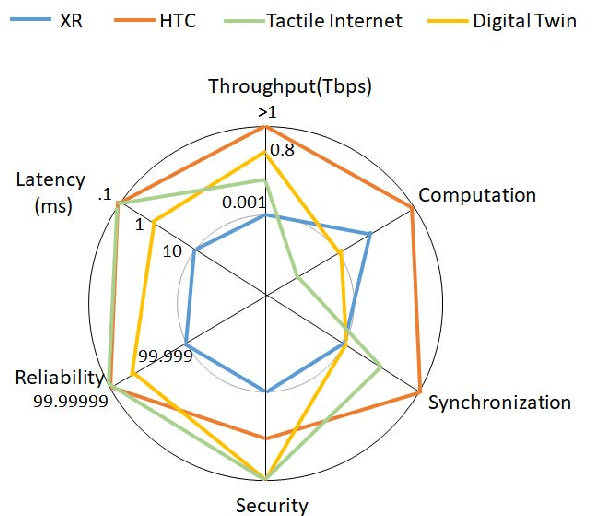
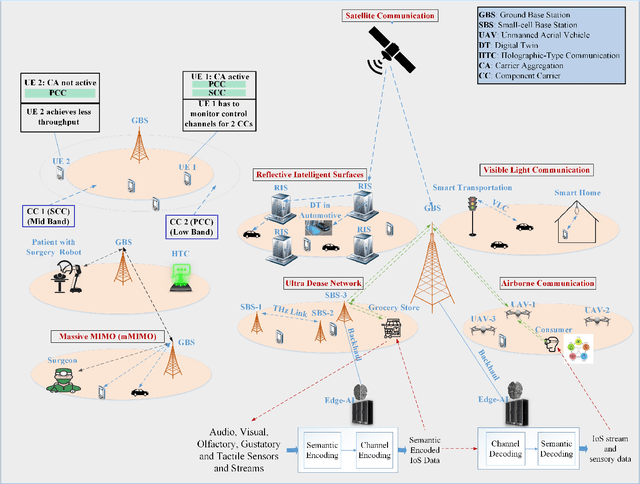
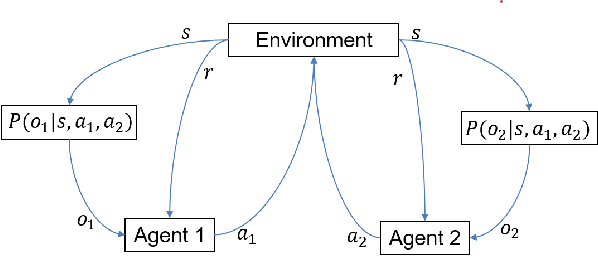
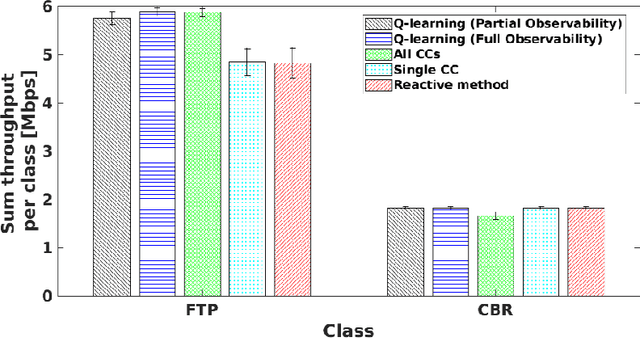
Abstract:The Internet of Senses (IoS) holds the promise of flawless telepresence-style communication for all human `receptors' and therefore blurs the difference of virtual and real environments. We commence by highlighting the compelling use cases empowered by the IoS and also the key network requirements. We then elaborate on how the emerging semantic communications and Artificial Intelligence (AI)/Machine Learning (ML) paradigms along with 6G technologies may satisfy the requirements of IoS use cases. On one hand, semantic communications can be applied for extracting meaningful and significant information and hence efficiently exploit the resources and for harnessing a priori information at the receiver to satisfy IoS requirements. On the other hand, AI/ML facilitates frugal network resource management by making use of the enormous amount of data generated in IoS edge nodes and devices, as well as by optimizing the IoS performance via intelligent agents. However, the intelligent agents deployed at the edge are not completely aware of each others' decisions and the environments of each other, hence they operate in a partially rather than fully observable environment. Therefore, we present a case study of Partially Observable Markov Decision Processes (POMDP) for improving the User Equipment (UE) throughput and energy consumption, as they are imperative for IoS use cases, using Reinforcement Learning for astutely activating and deactivating the component carriers in carrier aggregation. Finally, we outline the challenges and open issues of IoS implementations and employing semantic communications, edge intelligence as well as learning under partial observability in the IoS context.
POMDP-based Handoffs for User-Centric Cell-Free MIMO Networks
Aug 07, 2022
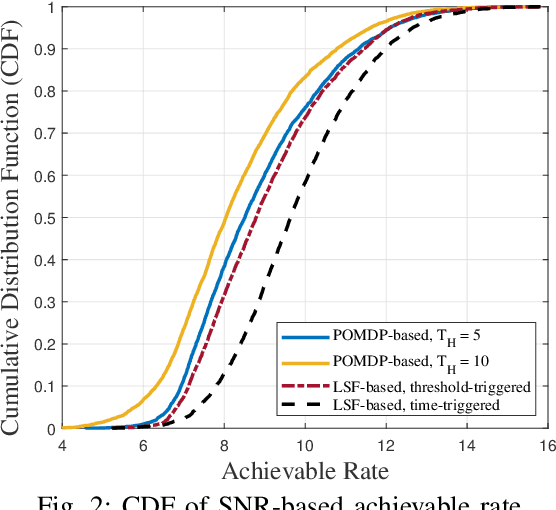
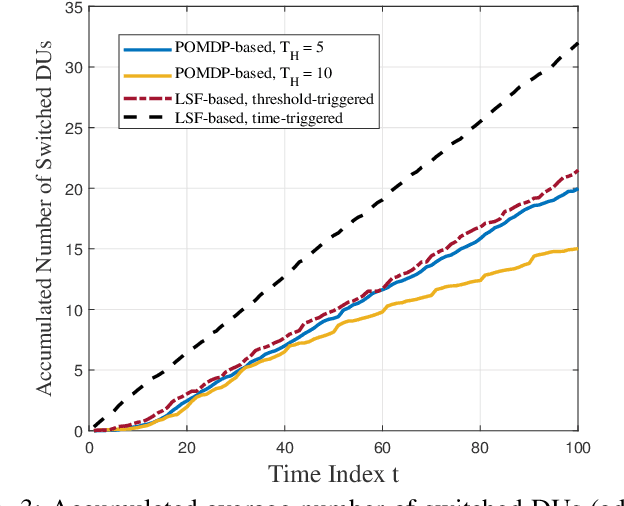

Abstract:We propose to control handoffs (HOs) in user-centric cell-free massive MIMO networks through a partially observable Markov decision process (POMDP) with the state space representing the discrete versions of the large-scale fading (LSF) and the action space representing the association decisions of the user with the access points. Our proposed formulation accounts for the temporal evolution and the partial observability of the channel states. This allows us to consider future rewards when performing HO decisions, and hence obtain a robust HO policy. To alleviate the high complexity of solving our POMDP, we follow a divide-and-conquer approach by breaking down the POMDP formulation into sub-problems, each solved individually. Then, the policy and the candidate cluster of access points for the best solved sub-problem is used to perform HOs within a specific time horizon. We control the number of HOs by determining when to use the HO policy. Our simulation results show that our proposed solution reduces HOs by 47% compared to time-triggered LSF-based HOs and by 70% compared to data rate threshold-triggered LSF-based HOs. This amount can be further reduced through increasing the time horizon of the POMDP.
Analysis and Design of Distributed MIMO Networks with a Wireless Fronthaul
Nov 18, 2021


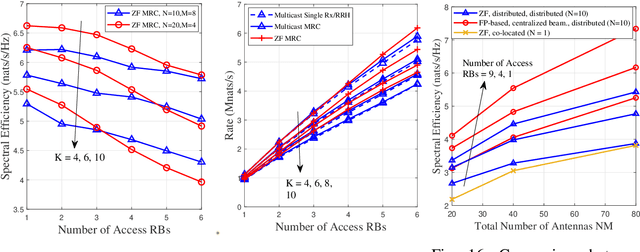
Abstract:We consider the analysis and design of distributed wireless networks wherein remote radio heads (RRHs) coordinate transmissions to serve multiple users on the same resource block (RB). Specifically, we analyze two possible multiple-input multiple-output wireless fronthaul solutions: multicast and zero forcing (ZF) beamforming. We develop a statistical model for the fronthaul rate and, coupled with an analysis of the user access rate, we optimize the placement of the RRHs. This model allows us to formulate the location optimization problem with a statistical constraint on fronthaul outage. Our results are cautionary, showing that the fronthaul requires considerable bandwidth to enable joint service to users. This requirement can be relaxed by serving a low number of users on the same RB. Additionally, we show that, with a fixed number of antennas, for the multicast fronthaul, it is prudent to concentrate these antennas on a few RRHs. However, for the ZF beamforming fronthaul, it is better to distribute the antennas on more RRHs. For the parameters chosen, using a ZF beamforming fronthaul improves the typical access rate by approximately 8% compared to multicast. Crucially, our work quantifies the effect of these fronthaul solutions and provides an effective tool for the design of distributed networks.
Distributed Resource Allocation Optimization for User-Centric Cell-Free MIMO Networks
Oct 15, 2021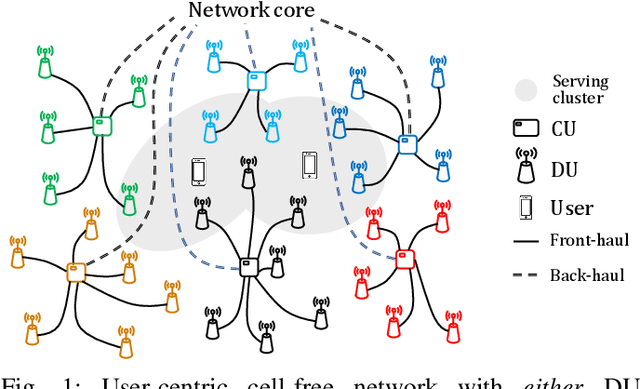
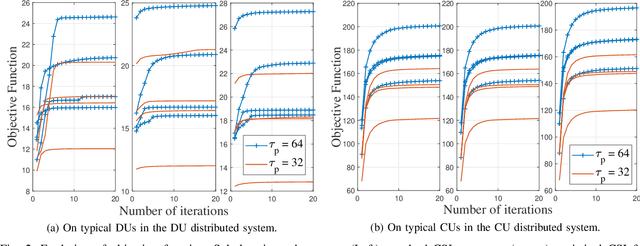

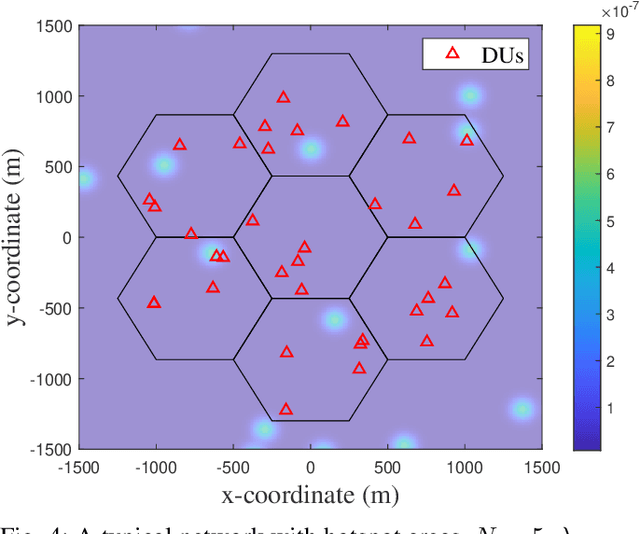
Abstract:We develop two distributed downlink resource allocation algorithms for user-centric, cell-free, spatially-distributed, multiple-input multiple-output (MIMO) networks. In such networks, each user is served by a subset of nearby transmitters that we call distributed units or DUs. The operation of the DUs in a region is controlled by a central unit (CU). Our first scheme is implemented at the DUs, while the second is implemented at the CUs controlling these DUs. We define a hybrid quality of service metric that enables distributed optimization of system resources in a proportional fair manner. Specifically, each of our algorithms performs user scheduling, beamforming, and power control while accounting for channel estimation errors. Importantly, our algorithm does not require information exchange amongst DUs (CUs) for the DU-distributed (CU-distributed) system, while also smoothly converging. Our results show that our CU-distributed system provides 1.3- to 1.8-fold network throughput compared to the DU-distributed system, with minor increases in complexity and front-haul load - and substantial gains over benchmark schemes like local zero-forcing. We also analyze the trade-offs provided by the CU-distributed system, hence highlighting the significance of deploying multiple CUs in user-centric cell-free networks.
Downlink Resource Allocation in Multiuser Cell-free MIMO Networks with User-centric Clustering
Aug 13, 2021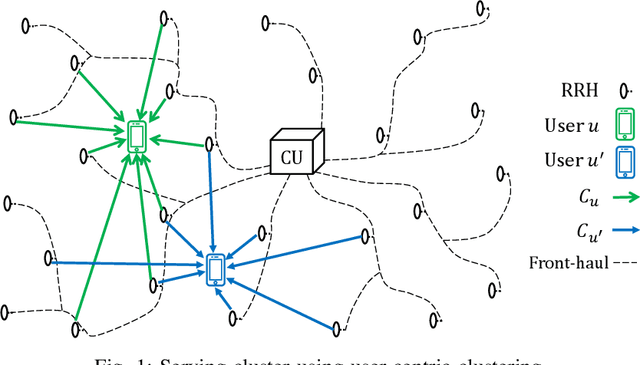
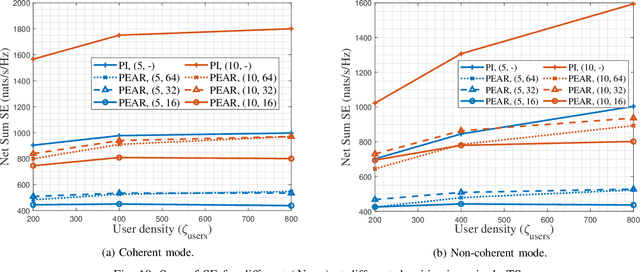
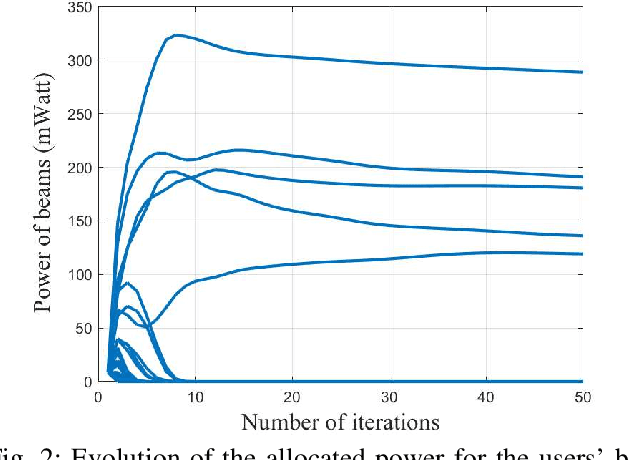
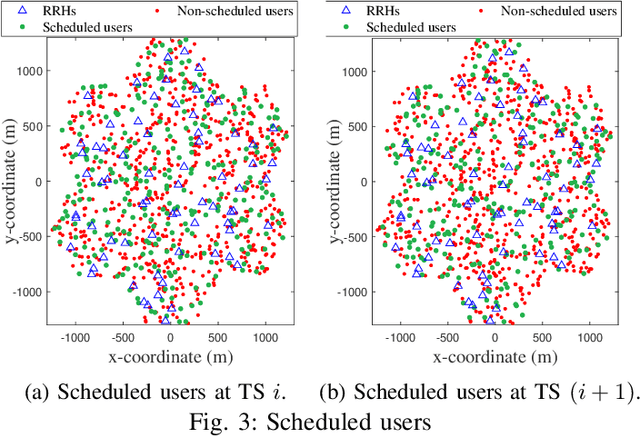
Abstract:In this paper, we optimize user scheduling, power allocation and beamforming in distributed multiple-input multiple-output (MIMO) networks implementing user-centric clustering. We study both the coherent and non-coherent transmission modes, formulating a weighted sum rate maximization problem for each; finding the optimal solution to these problems is known to be NP-hard. We use tools from fractional programming, block coordinate descent, and compressive sensing to construct an algorithm that optimizes the beamforming weights and user scheduling and converges in a smooth non-decreasing pattern. Channel state information (CSI) being crucial for optimization, we highlight the importance of employing a low-overhead pilot assignment policy for scheduling problems. In this regard, we use a variant of hierarchical agglomerative clustering, which provides a suboptimal, but feasible, pilot assignment scheme; for our cell-free case, we formulate an area-based pilot reuse factor. Our results show that our scheme provides large gains in the long-term network sum spectral efficiency compared to benchmark schemes such as zero-forcing and conjugate beamforming (with round-robin scheduling) respectively. Furthermore, the results show the superiority of coherent transmission compared to the non-coherent mode under ideal and imperfect CSI for the area-based pilot-reuse factors we consider.
Resource Allocation for Massive MIMO HetNets with Quantize-Forward Relaying
May 24, 2021
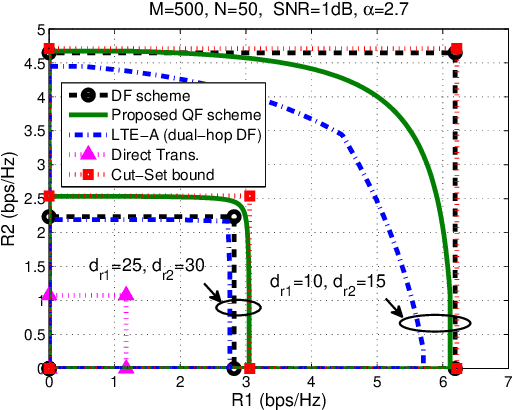


Abstract:We investigate how massive MIMO impacts the uplink transmission design in a heterogeneous network (HetNet) where multiple users communicate with a macro-cell base station (MCBS) with the help of a small-cell BS (SCBS) with zero-forcing (ZF) detection at each BS. We first analyze the quantize-forward (QF) relaying scheme with joint decoding (JD) at the MCBS. To maximize the rate region, we optimize the quantization of all user data streams at the SCBS by developing a novel water-filling algorithm that is based on the Descartes' rule of signs. Our result shows that as a user link to the SCBS becomes stronger than that to the MCBS, the SCBS deploys finer quantization to that user data stream. We further propose a new simplified scheme through Wyner-Ziv (WZ) binning and time-division (TD) transmission at the SCBS, which allows not only sequential but also separate decoding of each user message at the MCBS. For this new QF-WZTD scheme, the optimal quantization parameters are identical to that of the QF-JD scheme while the phase durations are conveniently optimized as functions of the quantization parameters. Despite its simplicity, the QF-WZTD scheme achieves the same rate performance of the QF-JD scheme, making it an attractive option for future HetNets.
Delay-Tolerant Constrained OCO with Application to Network Resource Allocation
May 09, 2021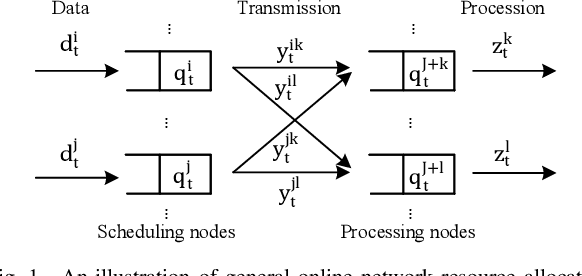
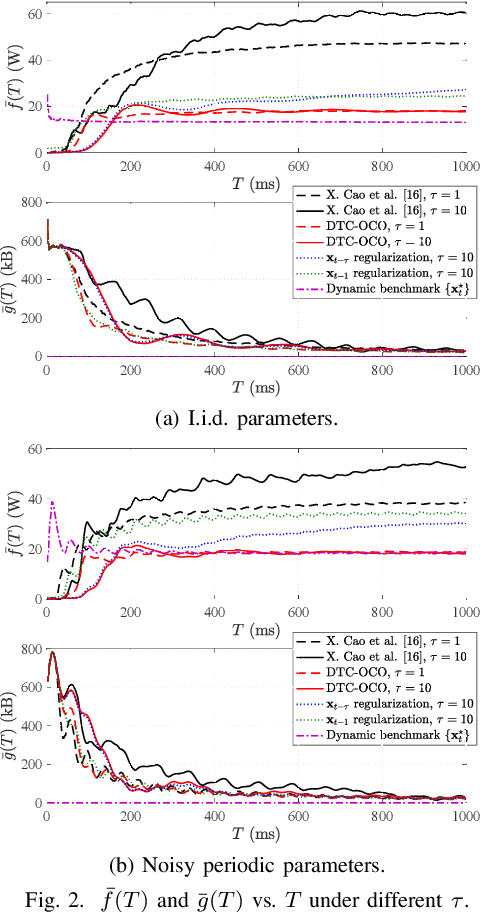

Abstract:We consider online convex optimization (OCO) with multi-slot feedback delay, where an agent makes a sequence of online decisions to minimize the accumulation of time-varying convex loss functions, subject to short-term and long-term constraints that are possibly time-varying. The current convex loss function and the long-term constraint function are revealed to the agent only after the decision is made, and they may be delayed for multiple time slots. Existing work on OCO under this general setting has focused on the static regret, which measures the gap of losses between the online decision sequence and an offline benchmark that is fixed over time. In this work, we consider both the static regret and the more practically meaningful dynamic regret, where the benchmark is a time-varying sequence of per-slot optimizers. We propose an efficient algorithm, termed Delay-Tolerant Constrained-OCO (DTC-OCO), which uses a novel constraint penalty with double regularization to tackle the asynchrony between information feedback and decision updates. We derive upper bounds on its dynamic regret, static regret, and constraint violation, proving them to be sublinear under mild conditions. We further apply DTC-OCO to a general network resource allocation problem, which arises in many systems such as data networks and cloud computing. Simulation results demonstrate substantial performance gain of DTC-OCO over the known best alternative.
 Add to Chrome
Add to Chrome Add to Firefox
Add to Firefox Add to Edge
Add to Edge